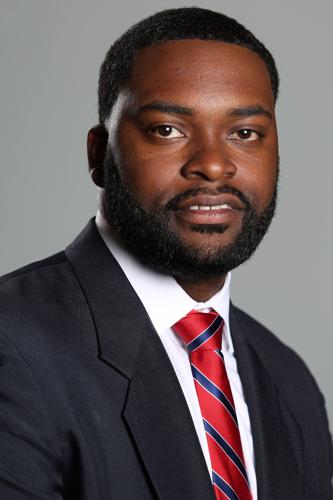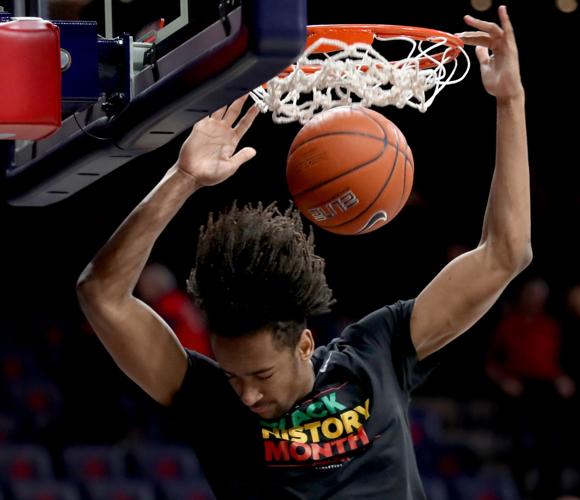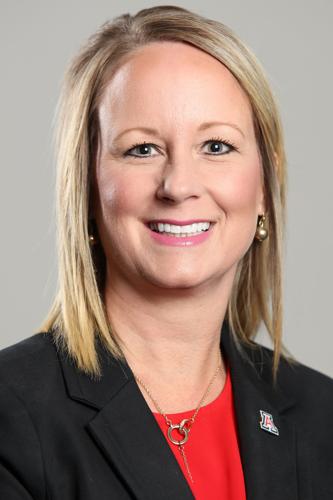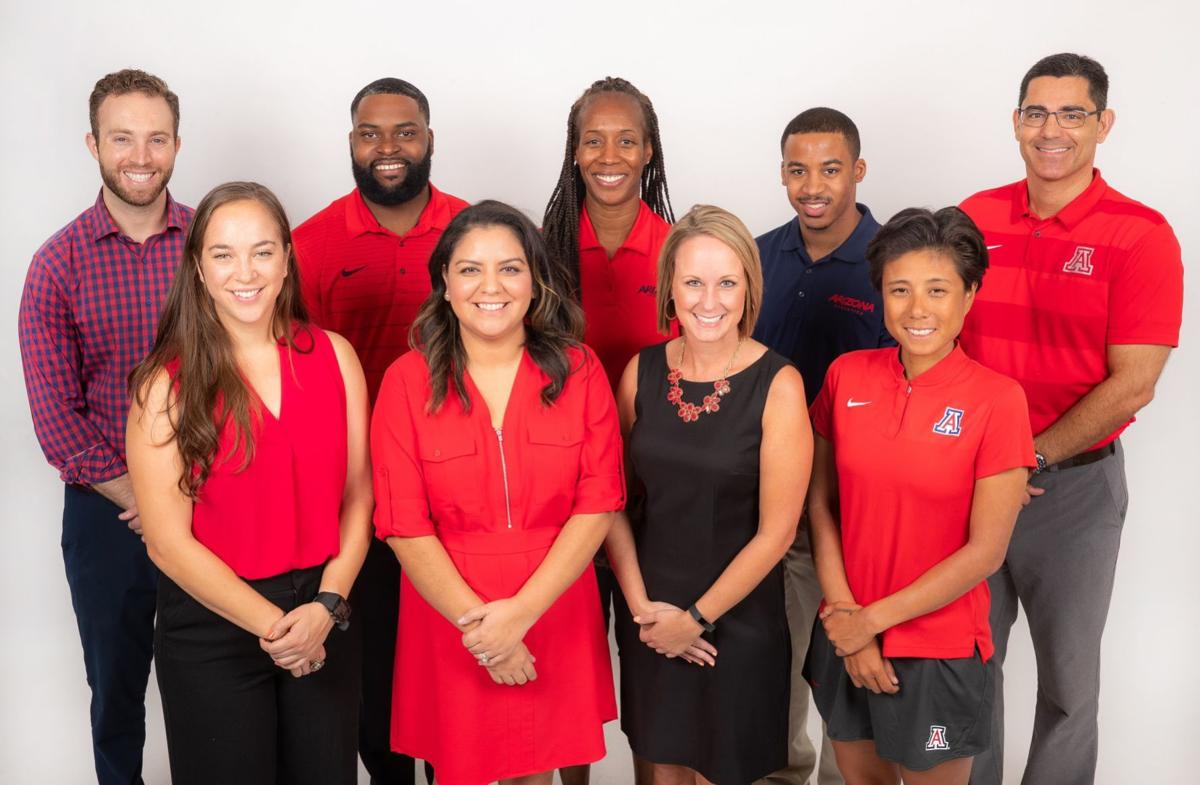Thomas Harris arrived at the UA in August 2016, the newest hire in the athletic department’s marketing office, knowing exactly nobody. The Kentucky transplant had never seen Tucson before — much less McKale Center or Arizona Stadium.
Charita Stubbs became, in his words, “a blessing.” The UA assistant women’s volleyball coach showed Harris the best places to go, both on campus and in town, and told him where he could find people who looked like him. As a result, Harris — who, like Stubbs, is African American — felt both included and comfortable in a strange new city.
The University of Arizona’s athletic department is expanding its efforts to help attract — and then keep — top coaches and administrators on campus. And it’s Harris, entering his fourth year at the UA, who is leading the way. Harris co-chairs the UA’s Inclusive Excellence Council, which was designed to increase and support inclusion, build trust and appreciate the differences among athletes and staff workers. The athletic department has about 200 full-time employees; add in student employees and part-time event staffers, and that number grows to close to 500.
In July, Harris was named the UA’s first-ever assistant athletic director of diversity, inclusion and employee engagement. He, along with senior associate AD Krystal Swindlehurst, are trying to make McKale Center as welcoming as possible for all types of people. Consider them the UA’s two top recruiters — except they’re luring coaches and administrators instead of athletes.
‘We love to see the returners’

Krystal Swindlehurst
As the UA’s senior associate athletic director for human resources, internal operations and strategic planning, Swindlehurst helped create the IEC. It was among the first things she did upon arriving in Tucson in January from Central Michigan University, where she worked alongside UA athletic director Dave Heeke.
It made sense to start there: The IEC was “a great high-energy, very impactful initiative for me to take on as a new leader here,” Swindlehurst said, adding that a lot of thought went into in deciding who can be a part of the IEC, so that the group would be representative of the diversity within athletics.
Harris, then working in marketing, signed on as co-chair. Harris said his passion for the IEC’s subject matter drew him to the group.
The IEC’s first tasks included organizing the department’s Black History Month celebration and creating a “Lunch and Learn” series. Last month, the department held its 11th “Lunch and Learn” event, to which all staff and student-athletes are welcome to attend. Topics have included freedom of speech, LGBTQ inclusion and race and ethnicity. Student-athletes provide feedback on what the department does well and what needs improvement.
“We love to see the returners, but we also love to see that the returners are bringing their friends and people that they share an office with,” Harris said. “It’s grown pretty much every time.”
“Lunch and Learn” is the IEC’s most highly attended event, with 30 to 40 staffers typically in attendance.
‘Pick your group and live with it for a little bit’
By the end of the 2018-19 school year, it became clear that a full-time leadership position would be necessary to advance the IEC’s goals of ensuring that employees felt like part of the athletic department.
Harris fit the bill: He spent his first few months on the job listening to various department leaders and partners. He found that many employees wanted to join the IEC. At the start of this school year, they introduced five separate subcommittees within the IEC, each focusing on a specific area. These areas include employee engagement, identities, student-athletes, employee recruitment and retention, and women leaders in sports.
Swindlehurst and Harris called the process “discussion-based learning,” saying that there was no specific plan for what the subcommittees would accomplish aside from advancing the IEC’s goals of engagement and inclusion.
“We told them, ‘Just pick your group and live with it for a little bit, and identify the challenges we need to address coming into the fall of 2020,’” Harris said.
The employee-engagement subcommittee handles what Harris and Swindlehurst called “the fun stuff,” including a biweekly fitness class led by the Wildcats’ strength and conditioning coaches. This subcommittee also plans the department’s holiday celebrations, potlucks and birthday acknowledgments.
Some of the other committees are more self-explanatory. The identities group helps plan any multicultural and identity-based programs and celebrations, including Black History Month and Hispanic heritage events. The women leaders in sports subcommittee focuses on executing the mission of the department’s Advancement of Women in Athletic Administration Program.
The student-athlete group assists C.A.T.S. Life Skills in planning student-focused events and programs that showcase diversity and inclusion.
‘Most people never really think about their networks’

Thomas Harris
Harris focuses much of his energy on the Employee Recruitment and Retention subcommittee, which focuses on developing strategies for recruitment, onboarding and retention.
Harris started by making sure that search committees were made up of a diverse group of people. He then gathered data from human resources to determine what kind of people have applied for jobs in the athletic department, who receives interviews and who gets hired. He learned that diverse candidates are in fact applying for jobs.
“I believe this is due to us posting our vacancies on job message boards that target minorities who work in sports,” he said.
Harris encourages hiring managers to network and ask for recommendations of diverse candidates to fill vacant positions. He has also created a LinkedIn page to both post vacancies within the athletic department and promote IEC activities, saying that the following has grown in the two months since it started. The job and message boards often attract people who might not see job postings in other forums.
“Most people never really think about their networks. They think about the people they talk to all the time, but they don’t think about the people they only see at conferences once a summer,” Harris said. “Those are the people who have some people waiting in line for the next position, so tapping into that pool has been great as well.”
Swindlehurst said she wants to make the UA as attractive as possible to all job candidates. Last month, an out-of-state applicant mentioned the IEC’s diversity and inclusion efforts to a hiring manager.
‘It’s just like recruiting: We don’t forget about you’

As part of its employee engagement efforts, the UA athletic department’s strength and conditioning coaches hold a fitness class for department employees twice a week. The department’s registered dietitian also attends the 60-minute classes, giving nutritional tips and ideas for meal plans and healthy eating.
As part of his new job, Harris meets with recruits during on-campus visits. He’s also created a diversity handbook that coaches share with potential student-athletes, which Harris says helps the UA get a leg up on other schools.
Recruiting is about more than just landing high school seniors, though. Harris and Swindlehurst put similar energy into luring potential job candidates while keeping quality staffers in McKale Center.
Harris is hoping that the department’s transition from new-employee orientation to onboarding — a subtle but important change — will give it a leg up when it comes to employee retention. Harris is now the first person new employees see on their first day in the athletic department. New hires receive a manual, which Harris compares to a “brag book,” as well as a new-hire survival kit complete with UA gear, office supplies and a Hydro Flask.
The goal, Swindlehurst said, is to make the new job as stress-free as possible, noting that many new hires have just relocated to Tucson from somewhere else.
“Some of the small things that seem big when you have a million other things going on with your relocation, we feel a responsibility to try to relieve new hires of that stress,” Swindlehurst said. “The sense of belonging, feeling like you belong. That’s the part that really matters to us.”
Swindlehurst called her move to Tucson from Central Michigan “professional development,” adding that she can relate to the UA’s out-of-state hires.
“When it comes to retention, it starts with onboarding,” Harris said. “It’s just like recruiting: We don’t forget about you. We want to talk to you within that two-week window before you get here and make sure everything is OK — and then once you get here, onboard you in a good way.”
‘Honoring their culture like they would want to’

Arizona forward Zeke Nnaji sports a warm-up shirt celebrating Black History Month as the Wildcats get ready to face USC at McKale Center, February 6, 2020 Tucson, Ariz.
The IEC works closely with on-campus groups on events such as the annual Hispanic Heritage Night at Arizona Stadium.
“We want to make sure we have people from the community, people from our Guerrero Center, and also Hispanic-identified students in the room — so we’re not just doing what we want to do, but we’re honoring their culture and heritage like they would want to,” Harris said.
The athletic department did something similar when it planned Native American Heritage Month, developing a tie-in with the women’s basketball program and an on-field presentation with Heeke and a tribal leader during a Wildcats football game.
It also works with community partners for Black History Month and Asian Pacific American Heritage Month.
“It’s important that all of those groups, we give them at least one sport that we can display their culture and heritage,” Harris said. “It not only represents our campus, but it represents Tucson and the diversity that it offers.”
While Harris and Swindlehurst are pleased with the direction of the IEC thus far, they’re continuing to look for new ways to engage employees and student-athletes. In the fall, the IEC launched Wellness Wednesdays, tackling topics from mental health to healthy eating. Particularly popular in the series are the free smoothies, Swindlehurst said.
Next, the pair hope to redesign the department’s intranet and develop a series of trainings. They’re also hoping to start lifelong learning conferences and on-campus events for employees.
“Just seeing the change in some of the folks we get to deal with has been so rewarding,” Harris said. “Employees just stop by and they pick our brains and talk about successes and headaches. To see them take our advice and implement it in their world has a huge positive impact.”









